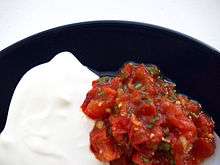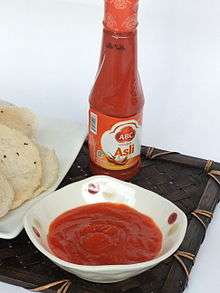Chili sauce

Chili sauce is a condiment prepared with chili peppers and sometimes red tomato as primary ingredients. Chili sauce may be hot, sweet or a combination thereof, and may differ from hot sauce in that many sweet[1][2] or mild varieties exist, which is typically lacking in hot sauces. Several varieties of chili sauce include sugar in their preparation,[3] such as sweet chili sauce[4] and Thai sweet chili sauce, which adds sweetness to their flavor profile. Chili sauce may have a thicker texture and viscosity when compared to that of hot sauces.
Chili sauce can be used as a dipping sauce, cooking glaze[4] and marinade.[5] Sweet chili sauce is used in Thai cuisine,[6] and is also sometimes used in the preparation of sushi.[7]
Many commercial varieties of mass-produced chili sauce exist.
Ingredients
Ingredients typically include puréed or chopped chili peppers, vinegar, sugar and salt[8] that are cooked, which thickens the mixture. Additional ingredients may include, water, garlic, other foodstuffs, corn syrup, spices and seasonings.[4] Some varieties use ripe red puréed tomato as the primary ingredient.[3]
Varieties
Commercial varieties
Many commercial varieties of mass-produced chili sauce exist. Some commercially produced chili sauces are canned, with red tomato that is processed into a pulp used as the primary ingredient.[3] The H. J. Heinz Company is one major producer of chili sauces.[9] In the United States, commercially produced chili sauces are assigned various grades per their quality.[10] These grades include U.S. Grade A (also known as U.S. Fancy), U.S. Grade C (also known as U.S. Standard) and Substandard.[10] Criteria in food grading for chili sauces in the U.S. includes coloration, consistency, character, absence of defects and flavor.[10]
Sriracha sauce (commercial)
Sriracha sauce, a type of hot chili sauce manufactured by Huy Fong Foods, has become increasingly popular in the United States in contemporary times.[11]
Sambal sauce

In Indonesia, the bottled commercially available chili sauce is known as bottled saus cabai. They are also commonly known as bottled sambal. However, unlike the coarse textured and richly flavored traditional sambal, this bottled sambal or chili sauce has an even gloppy texture similar to those of tomato sauce, and rather simple hot flavor. Unlike traditional sambal, enrichened with shrimp paste, the commercial sambal sauce usually uses finely blended red chili pepper and garlic, and sometimes a little bit of sugar, without any addition of shrimp paste.
Sriracha sauce (general)
Sriracha sauce is a type of hot sauce or chili sauce made from a paste of chili peppers, distilled vinegar, garlic, sugar, and salt. It is named after the coastal city of Si Racha, in the Chonburi Province of Eastern Thailand, where it was possibly first produced for dishes served at local seafood restaurants.[12]
Thai sweet chili sauce
A type of chili sauce is Thai sweet chili sauce,[13][14] which is used as a dipping sauce, a marinade, and for cooking, such as in stir fried dishes.[14] The company Mae Ploy is a major manufacturer of Thai sweet chili sauce.[13] Most major supermarket chain stores in North America carry Thai sweet chili sauce.[14]
Some versions of Nam phrik, a range of chili-based, hot sauces typical of Thai cuisine, are sweetened with sugar.
See also
- Chili oil
- Chili pepper paste
- List of condiments
- List of hot sauces
- Nam chim – Thai language term for dipping sauce
- Sambal – A type of Chili sauce with shrimp paste condiment, common in Indonesia
References
- ↑ The Gypsy Kitchen, Lisa Lamme. p. 57.
- ↑ The Everything Thai Cookbook, Jam Sanitchat. p. 164.
- 1 2 3 Handbook of Vegetable Preservation and Processing. pp. 162–164.
- 1 2 3 The Asian Grocery Store Demystified, Linda Bladholm. pp. 58–61.
- ↑ The Fishes & Dishes Cookbook, Kiyo Marsh, Tomi Marsh, Laura Cooper. p. 51.
- ↑ Caesars: The Essential Guide to Your Favourite Cocktail, Clint Pattemore
- ↑ Sushi For Dummies, Judi Strada, Mineko Takane Moreno
- ↑ Feeding the Dragon: A Culinary Travelogue Through China with Recipes
- ↑ Heinz adds 'thick' lines to chilli sauces
- 1 2 3 Tomato Production, Processing and Technology, WA Gould. pp. 460–462.
- ↑ Edge, John T. (May 19, 2009). "A Chili Sauce to Crow About". The New York Times. Retrieved 9 August 2014.
- ↑ Edge, John (May 19, 2009). "A Chili Sauce to Crow About". The New York Times. Retrieved 2013-02-15.
- 1 2 HOT! - Make Your Own Sauce! - Justin Thyme. p. 36.
- 1 2 3 Thai Cooking: A Step-by-Step Guide to Authentic Dishes Made Easy, Darlene Anne Schmidt. p. 18.
Further reading
- Yuan, Chuanzhen; (et al.) (2008). "Development of kelp chili sauce". China Brewing.
- Feng, Xiao; (et al.) (December 2006). "Study on the making of chili sauce with beef and lentinus edodes". Food Science and Technology.
- Zhang, Hui-jun; (et al.) (April 2011). "Simultaneous Determination of 14 Phthalate Esters in Chili Sauce by GPC-HPLC". Food Science.
- Juyi, Yin; (et al.) (June 2006). "Residues Determination of Para red by in Pimiento Catsup and Chili Sauce Sample by Gel Permeation Chromatography". Chinese Journal of Analytical Chemistry.
- ALOthman, Zeid A.; (et al.) (August 2012). "Membrane filtration of Sudan orange G on a cellulose acetate membrane filter for separation–preconcentration and spectrophotometric determination in water, chili powder, chili sauce and tomato sauce samples". Food and Chemical Toxicology. 50 (8): 2709–2713. doi:10.1016/j.fct.2012.05.021.
External links

